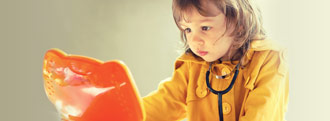Milestones for 2-Year-Olds
Overview
Children usually progress from one developmental milestone to the next. But each child grows and gains skills at their own pace. Some children may be advanced in one area, such as language and communication, but behind in another, such as movement and physical development.
Milestones usually are grouped into five major categories: physical growth, cognitive development, emotional and social development, language and communication development, and movement and physical development.
Physical growth
Most children by age 2:
- Have grown about 15 in. (38 cm) since birth.
- Gain weight and grow at a steady but slower pace than during their first 12 months of life. Between 12 and 24 months of age, expect your child to gain about 3 lb (1.5 kg) to 5 lb (2.5 kg), grow an average of 3 in. (7.5 cm) to 5 in. (13 cm), and gain about 1 in. (2.5 cm) in head circumference. (This is the measurement around the top of the head.) Go to www.cdc.gov/growthcharts to view standard growth charts.
Cognitive development (learning, thinking, problem-solving)
Most children by age 2:
- Can hold something in one hand while using the other hand, such as holding a container in one hand and taking off the lid with the other hand.
- Try to use the switches, knobs, or buttons on toys.
- Play with more than one toy at a time, like putting toy food on a toy plate.
Emotional and social development
Most children by age 2:
- Notice when other people are hurt or upset. They may pause what they are doing or look sad if someone is crying.
- Look at your face to see how to react in a new situation.
Language and communication development
Most children by age 2:
- Point to things in a book when you ask.
- Say at least two words together, like "more milk."
- Point to at least two body parts when you ask them to show you.
- Use more gestures than just waving and pointing. These could be things like blowing a kiss or nodding yes.
Movement and physical development
Most children by age 2:
- Kick a ball.
- Run.
- Walk up a few stairs with or without help.
- Eat with a spoon.
Credits
Current as of: October 24, 2024
Current as of: October 24, 2024






